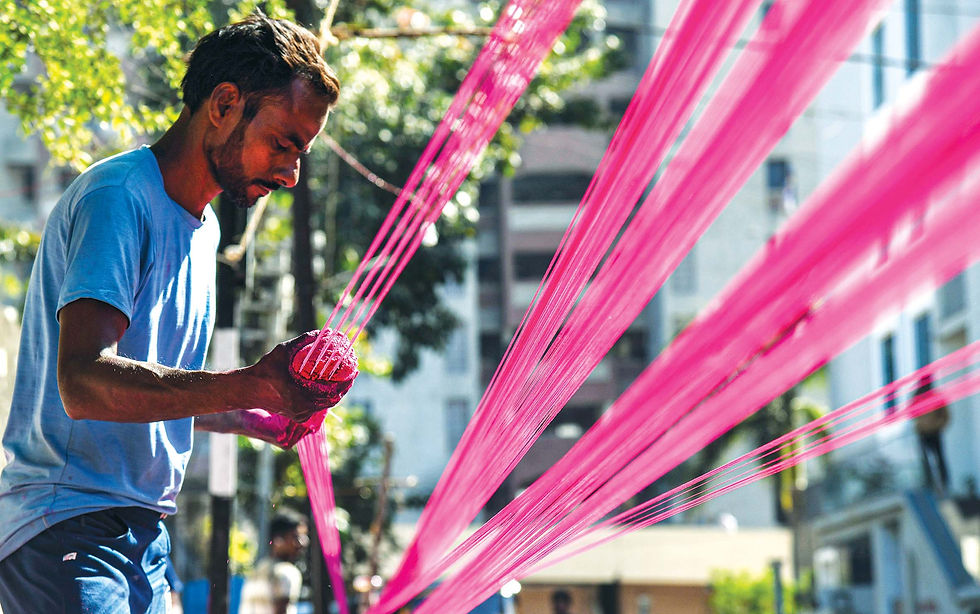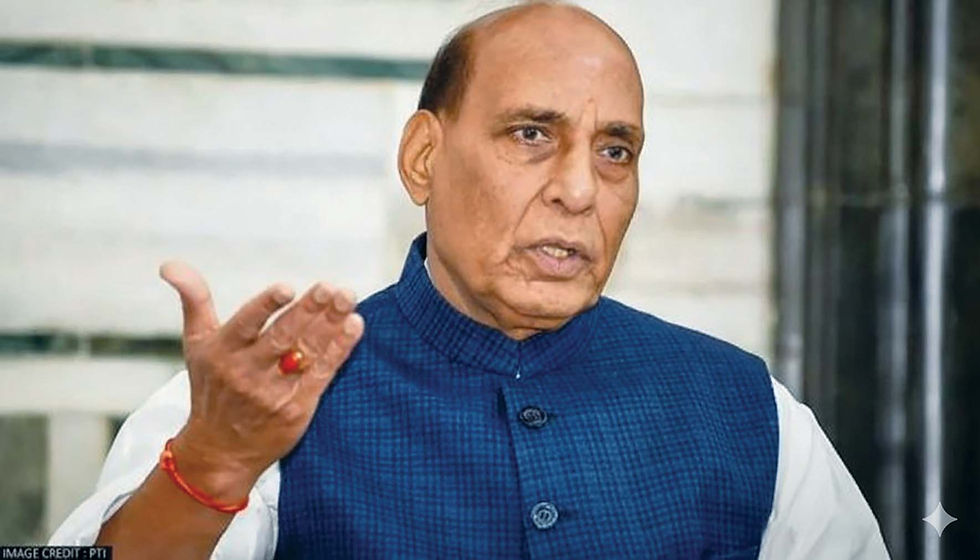The Betrayal of Kashmiriyat: Terror in God’s Own Meadows
- Shoumojit Banerjee

- Apr 27
- 5 min read
The Baisaran massacre shows how Kashmir’s militancy was always rooted in religious fundamentalism, not secular aspiration.

The horrific slaughter of more than 25 persons, mostly tourists, in the serene meadows of Baisaran, Pahalgam was a brutal reminder that beneath Kashmir’s recent economic gains and relative political calm, religious extremism remains deeply embedded. The killings were believed to have been carried out by The Resistance Front (TRF) - an offshoot of the Lashkar-e-Taiba (LeT) – but masterminded by Pakistan.
The murder of innocent tourists, after segregation on the basis of religion, was a disturbing throwback to the Islam-fuelled terrorism that defined Kashmir’s bloody decade of 1989-99.
It began in the shadows of Kashmir’s post-1947 politics, with the rise of the Jamaat-e-Islami. Founded in the valley in the early 1950s, Jamaat was an ideological outgrowth of Abul Ala Maududi’s Islamist project, which saw democracy, secularism, and nationalism as heresies against Islamic governance. In Kashmir, it set about creating parallel religious institutions: mosques, madrasas and welfare bodies aimed at weaving religion into the fabric of political consciousness.
Jamaat’s message was clear. Kashmir transcended the straitjacket of an ordinary political dispute. It was a battleground for Islam itself. Sheikh Abdullah’s secular nationalism, which envisioned Kashmir as a multi-faith society within a democratic India, was portrayed as apostasy. In the countryside, Jamaat’s missionaries worked diligently to discredit syncretic Sufism, dismantling centuries of Kashmiriyat, the shared cultural tradition that had once defined the valley.
Radicalisation grew quietly, until Maqbool Bhat’s Jammu and Kashmir Liberation Front (JKLF) erupted onto the scene in the 1960s and 70s. Though the JKLF initially espoused a secular and nationalist rhetoric, Bhat’s ideology leaned heavily on the idea of the alleged political betrayal of Kashmiri Muslims by India. His 1971 hijacking of an Indian Airlines plane - the Ganga hijacking - was a turning point in that it marked the open embrace of terror as a tool of political messaging. Bhat’s later execution in 1984 only deepened the narrative of martyrdom, encouraging radical groups to believe that violence alone could achieve political ends.
By the late 1980s, Kashmir was primed for insurgency. The Muslim United Front (MUF), a coalition including Jamaat, entered the 1987 Jammu and Kashmir elections to challenge Farooq Abdullah’s increasingly corrupt regime. The elections were rigged with barely concealed cynicism. Leaders like Mohammad Yusuf Shah (later Syed Salahuddin, the Hizbul Mujahideen chief) and Yasin Malik (future JKLF commander) were arrested as disillusionment among Kashmiri Muslim curdled into rage and violence.
But the form this violence took was telling. Instead of a ‘secular’ revolt against New Delhi’s injustice, the insurgency was quickly captured by Islamist groups whose visions were deeply exclusionary. Hizbul Mujahideen, founded in 1989 with direct assistance from Pakistan’s ISI, sought to impose Islamic rule over Kashmir and bring it under Pakistani control. Its militants systematically targeted Kashmiri Pandits, Sikhs, moderate Muslims and secular intellectuals.
This was closely watched by Zia-ul-Haq’s Pakistan across the border. Very soon, the ISI flooded Kashmir with battle-hardened jihadists from Afghanistan. Suicide bombings, mass killings of minorities and attacks on Hindu religious sites became commonplace.
Jihadist groups like Lashkar-e-Taiba, Jaish-e-Mohammed and Harkat-ul-Mujahideen further radicalised the landscape in the 1990s. Unlike the JKLF, which at least paid lip service to Kashmiri independence, these groups openly declared Kashmir part of a broader pan-Islamic war. Suicide bombings, assassinations of political opponents and mass killings of minorities became tactical norms.
The Islamisation of the conflict was methodical. Clerics issued fatwas against women without veils. Friday sermons thundered against India, against secularism, against democracy. The 1990 mass exodus of Kashmiri Pandits, forced by the militant slogan ‘Raliv, Chaliv, Galiv’ (convert, flee or die), was a carefully orchestrated purge.
Meanwhile, many of the men who had once extolled terror in the name of religion managed to carve out surprisingly comfortable lives. Syed Salahuddin, mastermind of Hizbul Mujahideen, lived openly in Pakistan, enjoying state protection. Yasin Malik, linked to multiple murders and kidnappings, reinvented himself for years as a ‘peaceful political activist’ before being imprisoned again. Even some former fighters turned real estate moguls. Through it all, it was the common Kashmiri Muslim - the shopkeeper, the farmer, the young student - who bore the cost of their holy war.
Ironically, while militants preached ascetic sacrifice and jihad, many indulged in earthly luxuries. Lavish homes in Rawalpindi, SUVs, business investments - the spoils of jihad have often been tangible. Few ever faced accountability.
Syed Ali Shah Geelani, the most influential Hurriyat hardliner, exemplified this duplicity. Geelani unapologetically demanded Kashmir’s merger with Pakistan on religious grounds, refusing to denounce the targeting of minorities or the use of terrorism as a tool. Under his leadership, Jamaat’s ideology suffused the political climate, sanctifying violence as a religious duty.
From its inception, Kashmir’s insurgency was marked not by democratic ideals but by an Islamist exclusivism. While groups differed over tactics and alignments - whether with Pakistan or a notional independent Islamic Kashmir - but seldom over the ultimate aim which was to transform Kashmir into a mono-religious polity governed by Islamic law.
It is in this context that Pahalgam’s tragedy strikes a deeper chord. For the past two decades, especially after Atal Bihari Vajpayee’s historic peace efforts in the early 2000s, Kashmir had begun clawing back toward normalcy. Tourism surged, businesses reopened and foreign investment trickled in. Prime Minister Narendra Modi’s government accelerated this economic stabilisation after 2019, investing heavily in infrastructure, connectivity and rural development.
Pahalgam itself became a symbol of hope. Once a playground of militants and armed convoys, it transformed into a bustling tourist town. Hotels flourished, pony rides became a thriving business and thousands of young Kashmiris found work guiding tourists rather than picking up guns.
The Baisaran massacre was an assault on this very hope - the fragile dream that Kashmir could have a future defined not by religion and blood, but by prosperity and peace.
Realising that overt Pakistani proxies like LeT had become internationally discredited, the ISI helped launch TRF which claims to be a ‘local’ movement fighting for Kashmir’s political rights. But its membership, methods and manifestos are indistinguishable from those of LeT. Its propaganda features the same religious motifs of jihadist terror: invocations of martyrdom, denunciations of non-Muslims and calls for Islamic solidarity.
TRF’s targeting of tourists was designed to poison this recovery, to once again cast Kashmir as a no-go zone of fear.
It would be comforting to believe that Kashmir’s violence can be soothed by economic development, dialogue or security operations alone. But the deeper challenge is ideological. So long as fundamentalist doctrines continue to find currency through radical mosques, online propaganda or political indulgence, the valley will remain vulnerable to eruptions of terror.
Reviving Kashmiriyat, that precious ideal of religious coexistence and cultural pluralism, is essential. But it will not happen through mere slogans. It demands an unflinching confrontation with the Islamist roots of the insurgency, a systematic dismantling of its ideological infrastructure and a political culture that prizes secular rights over sectarian ambitions.
Until then, the lush meadows of Pahalgam will remain bloodstained reminders of how far the valley has strayed from its own best traditions.





Comments